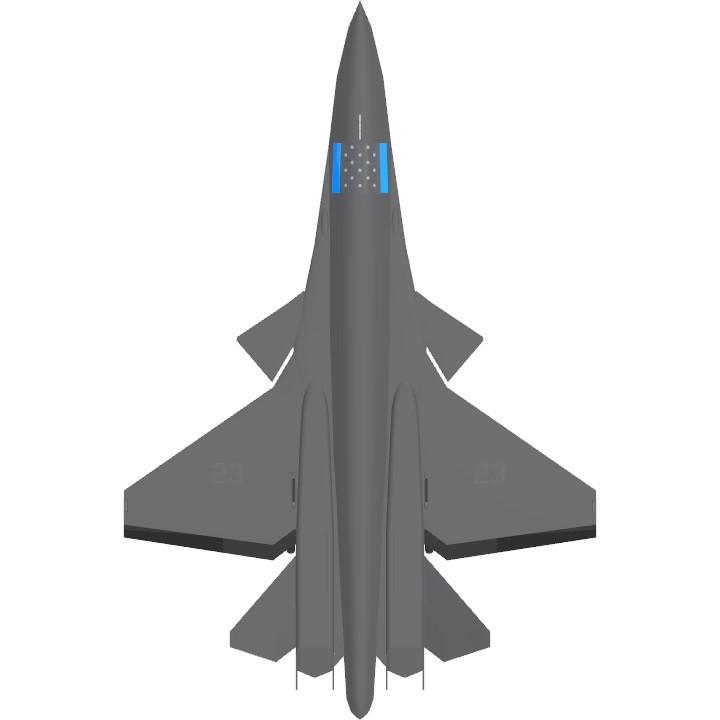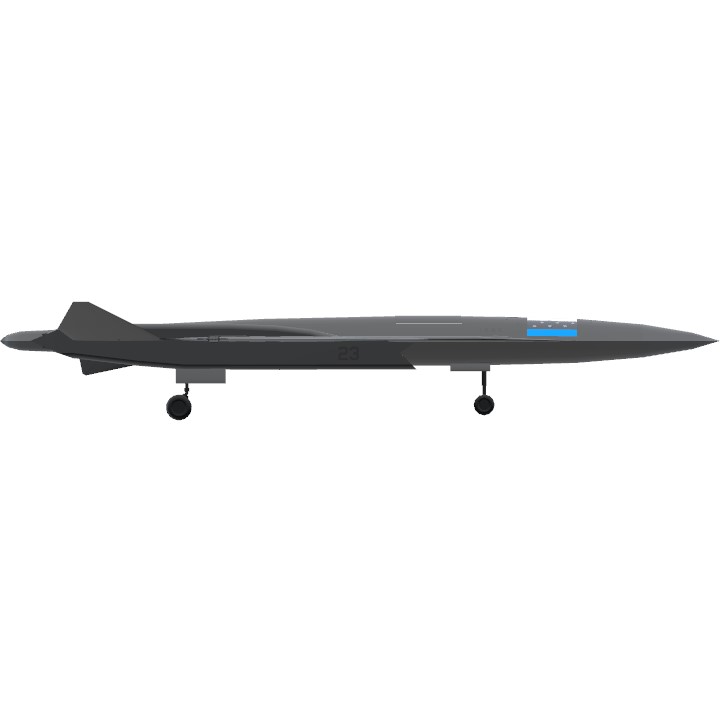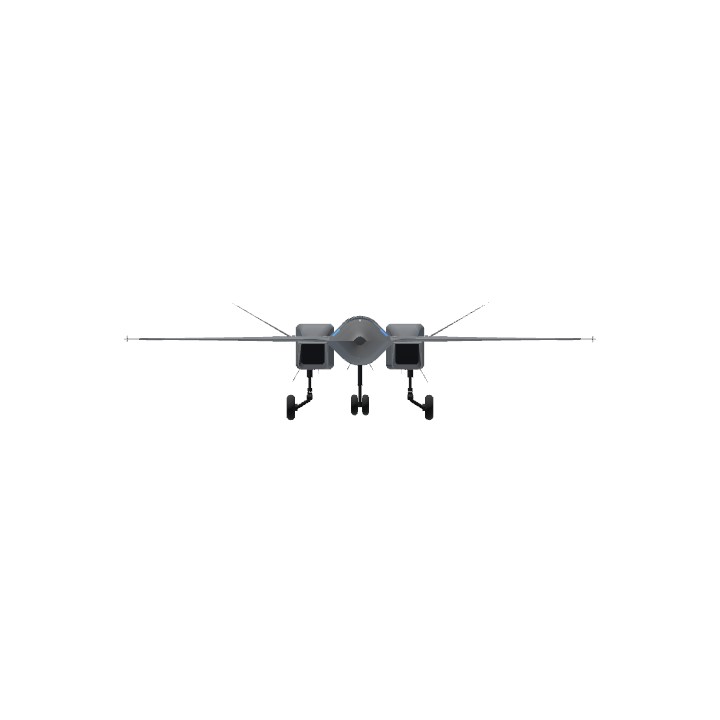
KAI/X-23A “Gemini II”
Kola Arms Industry, Experimental No. 23, Variant A, Gemini II
Prototype Black Color Scheme
Origin: Imperium Obelia
Manufacturer: Kola Arm Industry, FSS Research Division, Luminarium Aeronautics
Operator(s): Imperial Royal Airforce (IRAF)
Main Role: Prototype Autonomous Fighter
Piloting System: Gemini-S Advanced AI System
Designed: 2017-2031
In-service: 2040
Length: 23.5m
Wingspan: 15.4m
Height: 3.8m
Powerplant: 2x Cheirosiphon-B Afterburning Turbofan
Max Speed: 2.550kph on high altitude
Cruise Speed: 1.500kph
Range: 4.000km – 5000km
Armaments:
1 x 25mm Rotating Autocannon
4x RK/S-1 Short Range Air-to-Air Missile
4x RK/L-4S Beyond Visual Range Missile
Avionics:
Absolutio-C Electronically Scanning Array (AESA) Radar
1A9 Solus-C Infrared Search and Track (IRST)
3A7 Salve-K Self-Defense Radar
Luminarii MORTIS (Modular Offensive-Reactive Tactical Interception System) Electronic Warfare System
Gemini MASS (Multi-lenses Aerial Scanning System) AI Awareness System
DESCRIPTION

Kola Arm Industry's X-23A, also known as "Aurora" was an autonomous, AI-piloted unmanned air superiority fighter. It was designed to be a "perfect fighter", capable of observing, calculating and executing strategy with unmatched precision and speed. The base framework for it's flight and combat ability was based from the various records from earlier ace pilots in the South Obelia's War for Independence (2010-2019) and Second Floran-Obelian War (2021-2025), and continue in improving independently. Its ability outmatched most ace pilots if it's time. It calculates faster, turns sharper, and shoot more accurately than human pilot. Being an artificial intelligence also allows it to communicates to wingman human pilots who acted as guide and wingmen for it. The only drawbacks were its cost and limited independence as it relies on a programmed framework to work.
Aurora was capable of super cruise and supersonic speed with its two Cheirosiphon-B afterburning turbofan, equipped with 2-dimensional thrust vectoring nozzle for higher agility. The engines were relatively new, designed exclusively for X-23A by Luna-Morta Engineering Company. For powering electronics, it has several solar-charged batteries stored inside, ensuring the ability of long duration flight.
DEVELOPMENT HISTORY

The basis for X-23A started its development in the 1968, in the final few years of the 35 Year War. The project, initially codenamed "Neuron" under the Secret Program Initiative SPI/E-228F, kept in high secrecy by the Experimental Weapon Research Department of the Federal Strategic Service (FSS). However, as the war end and the Imperium split into 2, the project shut down and left in the secrecy for more than 20 years. The project continued in the late 1990s. Imperial loyalist and extremist of North Obelia, including "Oculus" Organization (in which consisted of former FSS members and their generations) brought the project back to life, and once more, under secrecy. However, funding constraint and lack of focus slowed the development a lot. In 2000s, Imperial extremists and loyalist focused more on gaining political influence rather than secret projects for time being. Thus, the project once again abandoned for another 15 years. However, it's AI framework continued its development alongside the general development flow of the AI technologies. This secret project produced early aerial AI system called “Hummingbird” which capable of producing “humming” tone by itself to communicate like a morse code.
In 2001, the loyalist managed to control over North Obelia as the oversea Allied force left North Obelia according to the Treaty of Rochefort (1970). They declared themselves as "Neo Imperium Obelia", and secretly building their military power once again. "Oculus" organization reform themselves as "Northern Obelia Strategic Bureau" and once more, continue the SPI/E-228F "Project Neuron", now renamed as "Project Gemini" as part of the "Initiative Vega". First experimental aircraft finished in 2017, the X-15A, codenamed Gemini I, referring to its AI-Assistant; Gemini-A. The aircraft were produced in limited number by Kola Arm Industry amidst the South Obelia's War for Independence. The aircraft features an unmanned cockpit with the pilots controlled the aircraft remotely from the ground, with Gemini-A’ guides to help them. However, the aircraft susceptible from hacking or jamming. If the pilot lost their connection, then the whole aircraft would lose control. However, the unmanned capability allows the aircraft to be extremely agile because the only limit to G-Force is the structural integrity itself, not the pilot.
Further development of the project leads to the XF-17A which introduced in early 2025 during the final stage of the Second Floran-Obelian War (2021-2025). With new system called Neuron-A, a more advanced AI-Assistant than Gemini-A. The AI works as co-pilot for the human pilot to help analyze and calculate many things from damage, range, interception method and more. However, XF-17A abandoned the drone pilot system, returned to traditional manned fighter jet to avoid hacking and connection failure. XF-17A went into separate project but remain under same Initiative as future combat aircraft.
In 2030, the project then renamed once more into "Project Whistling Bird" but remain under "Initiative Vega" alongside other projects of the same initiative. The name derived from one event when the AI mimics the whistling tone hummed by the scientist who forgot to turn it off while working on it. From there on, the whistling tone remains within its core memory. “Gemini-S” now had the ability to speak like human but it still “love” to whistle a song since the scientist refused to erase the whistling ability1, seeing it as its "personality". Despite the project name, the AI system itself was named "Gemini-S" or “Gemini II” since it is further improvement of Gemini-A with integration of Neuron-A within its system. The aircraft mainframe, codenamed X-23A, tested in 2031, but the true AI-piloted test started in 2032. The AI was fed with data and recording of earlier aces of the previous wars, and the test shown as promised. The AI win 5:1 against manned aircraft on its first mock combat training. It shown superior agility, calculation and execution, outmaneuvering even the best human pilot. The X-23A structure was made stronger with new material to withstand higher High-G maneuvers better than the predecessor, and the AI-pilot able to receive as much G-force as the aircraft could do and take, making it very effective in dogfight.
"Gemini-S" later shown to have a limited degree of personality in its vocal and written method of expression. Wingmen who served alongside it during sorties refer them to have a "mix between an all-knowing flying machine and an innocent child" due to its curiosity in many things beside aerial combat. Further test also shown a degree of self-improvement by reevaluating loss and mistakes. It received its first deployment during Austerland-Obelian War (2040-2043). It served within the 23rd Aerial Division, 1st Autonomous Squadron "Gemini" and under high secrecy. Although having its sorties limited, it proven itself to be effective during the war, capable of beating every Austerland ace pilots. The effectiveness further pushed the development into making something cheaper and viable for mass production. "Project Unborn" later issued as continuation of the now finished "Project Whistling Bird", still under "Initiative Vega". However, it still waiting for approval.
DEPLOYMENT HISTORY

X-23A was tested from 2031 and 2032, and had shown an outstanding performance with minor problems. However, it still deemed not ready for combat deployment. Official believed it was not "ready for combat" even though the actual reason is that they were worried the technology would lost to the enemy if it's ever shot down. However, as the Austerland-Obelian War (2050-2053) broke out, the officials reluctantly agreed to test the X-23A “Gemini II”, piloted by Gemini-S AI system in real combat scenario. The stakes were high if it's ever shot down, but fortunately it never got shot down. Over 40 sorties made, mostly patrol and air-supremacy, all were resulted in great success. During the "Fall Offensive", Gemini II shot down in total of 32 aerial score. The mystery plane was reported to Austerland officials, rumors and conspiracies spread about the "mysterious aces" until finally after the war, the project revealed to public. A newborn machine made as a weapon for war. Media predicted that by 2070, the skies will be filled by such unmanned aircraft.
Control
Fly like a normal aircraft
AG7 to Turn On Lights
VTOL for Flaps
Brake to Deploy Airbrakes
Specifications
Spotlights
- VeroViper 23 days ago
- ChihiroFujisaki 23 days ago
- TheFlightGuySP 23 days ago
- IAmSteve 23 days ago
General Characteristics
- Created On Windows
- Wingspan 50.6ft (15.4m)
- Length 77.3ft (23.5m)
- Height 12.5ft (3.8m)
- Empty Weight 23,085lbs (10,471kg)
- Loaded Weight 51,208lbs (23,228kg)
Performance
- Power/Weight Ratio 4.212
- Wing Loading 38.1lbs/ft2 (185.9kg/m2)
- Wing Area 1,344.8ft2 (124.9m2)
- Drag Points 11427
Parts
- Number of Parts 271
- Control Surfaces 6
- Performance Cost 1,506





Da empire
Average Ace Combat jet:
yippee it's out
TAGS
@KPLBall
TAGS
@Pnut
@MIGFOXHOUND31BSM26
@TheUltimatePlaneLover
TAGS
@Boeing727200F
@YarisSedan
@TheNewSPplayer